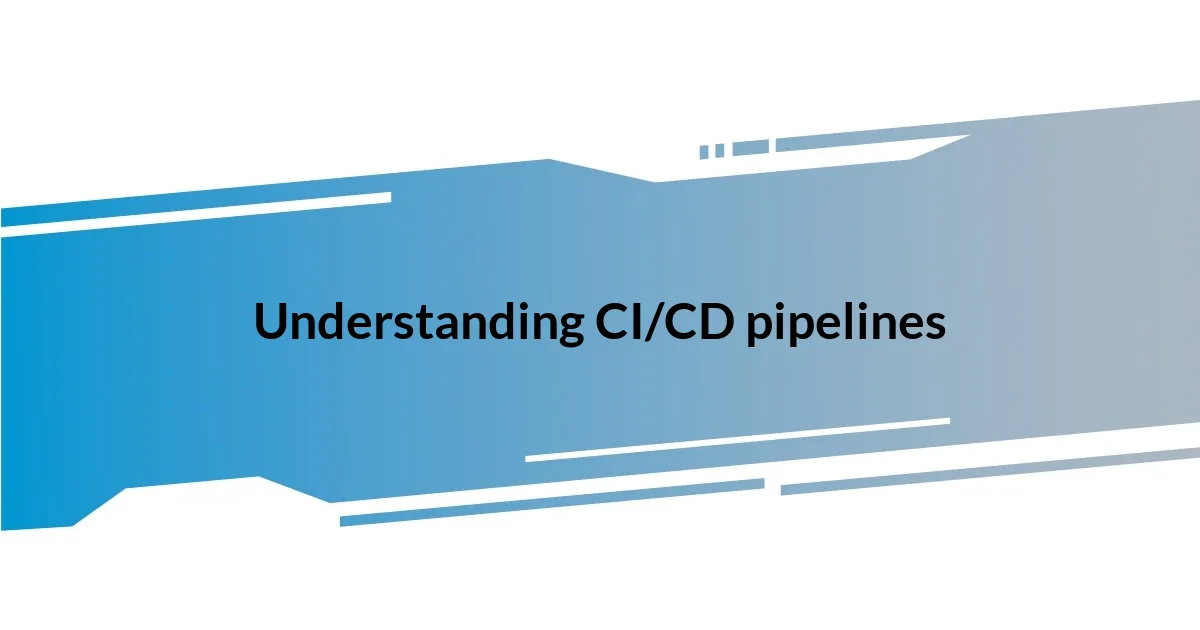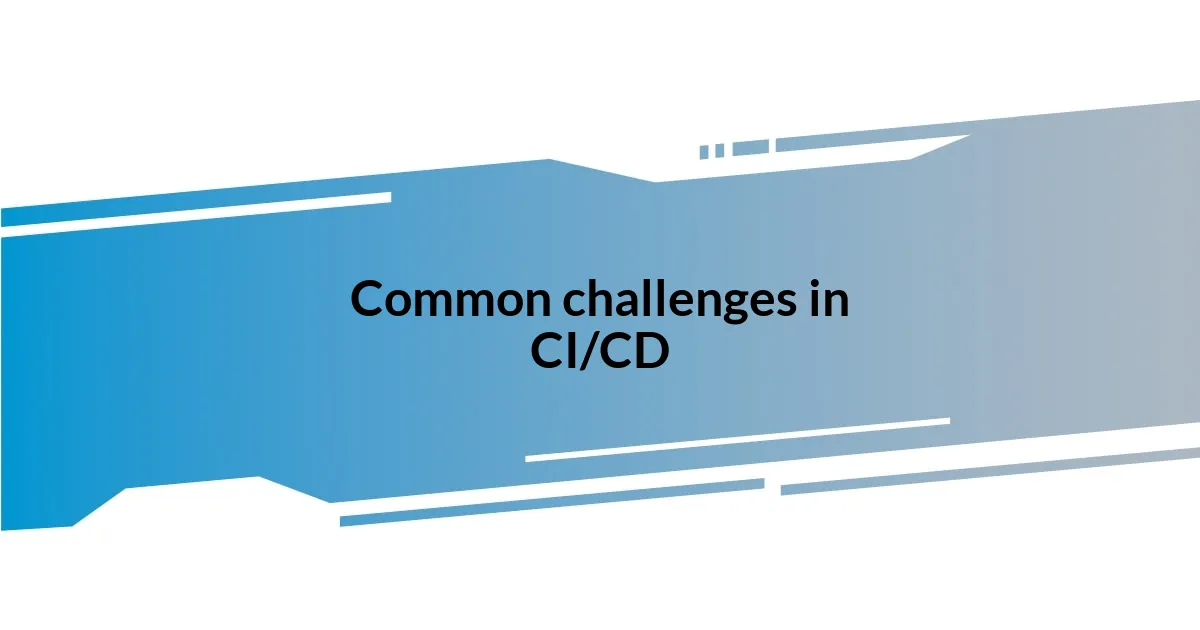Key takeaways:
- CI/CD enhances collaboration, reduces deployment-related anxiety, and fosters a culture of experimentation and continuous improvement within teams.
- Key components include Continuous Integration (CI), Continuous Deployment (CD), and Automated Testing, which streamline workflows and improve code quality.
- Common challenges include handling dependencies, infrastructure scalability, and fostering a strong testing culture; proactive planning can mitigate these issues.
- Future trends in CI/CD involve integrating AI and ML for automation, adopting GitOps for version-controlled infrastructure, and prioritizing security throughout the development process (DevSecOps).

Understanding CI/CD pipelines
CI/CD, which stands for Continuous Integration and Continuous Deployment, is a methodology that automates stages in software development. I remember when I first encountered CI/CD; it was like discovering a magic wand that could transform tedious tasks into seamless processes. It felt empowering to know that by integrating code frequently, teams could catch issues earlier, enhancing collaboration and reducing anxiety over looming deadlines.
The beauty of CI/CD lies in its ability to streamline workflows. Imagine working in an environment where integration doesn’t feel like a nightmare but rather a routine, checked off easily. I’ve seen teams thrive under this model—not just in terms of productivity, but also in morale. They celebrate not just the releases, but also the small victories along the way, which genuinely fosters a sense of accomplishment.
One common question that often arises is: how does CI/CD truly benefit teams in the long run? From my experience, the answer lies in consistency and reliability. Regularly deploying updates means you can respond faster to user feedback and market changes. I’ve witnessed companies grow significantly when they embraced CI/CD, turning what used to be a stressful process into a smooth and joyful journey of innovation.

Benefits of CI/CD pipelines
The benefits of CI/CD pipelines are both tangible and profound. One of the most immediate advantages I’ve noticed is the reduction in deployment-related anxiety. When I first started working with CI/CD, it amazed me how quickly teams could push updates out to users without fearing major blow-ups. It felt as if the culture shifted from “let’s hope this works” to “we’ve got this,” fostering a healthier and more trusting environment.
Here are some key benefits I’ve observed:
- Faster Time to Market: Teams can deploy new features and fixes quickly, gaining a competitive edge.
- Increased Collaboration: CI/CD fosters open teamwork among developers, reducing silos and improving communication.
- Improved Quality: Automated testing catches issues early, leading to higher-quality code.
- Consistent Feedback Loops: Rapid deployments allow for quicker user feedback, meaning adjustments can be made almost instantly.
- Greater Innovation: Teams can experiment without the fear of major failure, leading to a more creative approach to solving problems.
Embracing CI/CD feels liberating as I watch teams thrive, focusing on innovation rather than fear. The shift to continuous integration and deployment creates a culture of experimentation, enabling organizations to pivot and adapt in real time. I’ve seen this first-hand when a project team celebrated not only successful releases but also the learning process that went into each iteration, reminding us all that growth comes from both success and failure.

Key components of CI/CD pipelines
The key components of CI/CD pipelines are essential to understanding how they function effectively. At the core, there’s Continuous Integration (CI), where developers frequently merge their code changes into a shared repository. When my colleagues and I implemented CI, the excitement was palpable—we could see changes reflected in real-time, which not only fostered a collaborative spirit but also made our debugging processes much more efficient. I distinctly remember the feeling of relief when we eliminated those harrowing last-minute surprises that often crept in before deployment.
Next comes Continuous Deployment (CD), where all code changes that pass automated tests are automatically deployed to production. This was a game changer for us! I still recall the day we first had a fully automated pipeline; it felt surreal watching our code seamlessly transition from development to live environment with minimal human intervention. It created a sense of trust in the system, allowing us to focus on writing great code instead of worrying about deployment headaches.
Finally, we can’t overlook the importance of automated testing and monitoring in CI/CD pipelines. These components are like safety nets that catch issues before they reach the end user. I’ve been in situations where a minor bug could have turned into a disaster, but our automated tests caught it. The gratitude I felt towards our testing suite in that moment was immense. It not only protected our users but also bolstered the team’s confidence in the release process.
| Component | Description |
|---|---|
| Continuous Integration | Frequent code merging into a shared repository, enhancing collaboration and issue detection. |
| Continuous Deployment | Automated deployment of code changes that pass tests, simplifying the release process. |
| Automated Testing | Tests run automatically to identify bugs early, ensuring code quality before it reaches users. |

Best practices for CI/CD implementation
Integrating CI/CD effectively requires a solid understanding of its processes. One practice that stands out to me is establishing a clear branching strategy. I remember my team initially struggling with merge conflicts that felt like a puzzle gone wrong. After we adopted a consistent branching pattern, it transformed our workflow. We could easily pinpoint changes, and the relief at avoiding chaos during merges was palpable. Don’t underestimate the importance of this foundational step; it can significantly streamline your process.
Another best practice is to invest in comprehensive test suites early in your implementation. In my experience, dedicating time upfront to develop robust automated tests has been invaluable. I vividly recall a crucial feature launch where extensive testing paid off; not only did we catch critical defects, but we also felt a collective sense of pride in delivering quality software. Have you ever faced a rushed release that backfired? It’s a familiar scenario, but with the right testing framework, those worries can fade.
Finally, fostering a culture of continuous improvement is essential for long-term success. The idea of regularly reflecting on what works and what doesn’t can feel daunting, but it’s truly rewarding. I’ve seen teams grow stronger when they embrace feedback, celebrating their successes while learning from setbacks. Isn’t it invigorating to know that every deployment is an opportunity to learn? By creating a safe space for collaboration, you empower everyone to contribute to the journey, making the experience richer for all involved.

Common challenges in CI/CD
One common challenge I encountered in CI/CD pipelines is handling the complexity of dependencies. Picture those moments when one team’s updates suddenly break another’s feature downstream. It’s incredibly frustrating! I often found myself deep in discussions with colleagues, analyzing various dependencies to pinpoint the breaking change. Establishing clear communication can alleviate these tensions, but it requires diligence and commitment from everyone involved.
Another hurdle is the constant need for infrastructure scalability. I recall a particular instance when a sudden increase in users strained our system, leading to deploy failures. It was a wake-up call! We quickly realized that the infrastructure must be as adaptable as the code we deploy. If we had proactively planned for scalability, we could have avoided that stressful situation. Have you ever been caught off guard by your infrastructure’s limitations?
Lastly, fostering a strong testing culture can often feel like an uphill battle. I vividly remember when my excitement over rapid deployments clashed with the team’s reluctance to embrace thorough testing. I had to remind my peers that short-term speed can jeopardize long-term quality. Testimonials from users and critical post-deployment reviews reinforced this lesson, emphasizing the need for robust testing practices as a protective shield in our deployment journey. How can we expect to build trust with users if we don’t invest the effort in quality assurance?

Tools for effective CI/CD
When it comes to tools for an effective CI/CD pipeline, I’ve found that utilizing a robust version control system like Git is fundamental. Early on, I experienced the chaos of untracked changes across different team members, which left us all feeling disorganized and anxious about our progress. The shift to a centralized repository not only streamlined our changes but also fostered better collaboration; suddenly, we could all see who changed what and when. Isn’t it reassuring when a simple tool can bring the whole team together?
Another essential tool that has made a noticeable difference in my experience is Jenkins. This open-source automation server has a plethora of plugins that enable seamless integration with various development, testing, and deployment tools. I remember the first time I configured a Jenkins job to automate our deployment process—it felt exhilarating! Watching code changes trigger automated builds and tests in real time was like witnessing magic unfold before my eyes. Have you ever felt that thrill when technology works in perfect harmony?
Lastly, I can’t stress enough the importance of monitoring tools such as Prometheus or Grafana. Early in my journey with CI/CD, I neglected observability, which led to painful troubleshooting sessions post-deployment. I vividly recall a blunder when we didn’t realize a particular service was down until our users complained—talk about a gut punch! Since integrating monitoring tools, I’ve felt empowered to catch issues before they affect users. Isn’t it a huge relief when you can identify and resolve problems proactively rather than reactively?

Future trends in CI/CD pipelines
As I look into the future of CI/CD pipelines, one trend I find exciting is the increasing integration of artificial intelligence (AI) and machine learning (ML) into the automation process. I remember a project where manual code reviews consumed our time, leading to delays and frustration. Imagine having AI tools that can predict potential issues before they arise! This would not only accelerate deployment but also improve the overall quality of the software. Isn’t it thrilling to think about a future where our workflows are enhanced by intelligent automation?
Another trend I’ve noticed is the rise of GitOps as a methodology. I can clearly recall feeling overwhelmed by manual deployments and configuration changes. Transitioning to a GitOps approach felt like discovering a secret weapon—it empowered our team to declare our infrastructure as code. This paradigm emphasizes consistency and can drastically reduce errors, making deployments more predictable. Have you ever wished for a streamlined process where every aspect is version-controlled?
Finally, the growing emphasis on security within the CI/CD pipeline, often termed DevSecOps, is something I wholeheartedly support. Early on, I overlooked security measures, believing they could be tacked on later, and I faced some genuinely frightening moments when vulnerabilities were discovered post-deployment. Now, incorporating security at every stage feels like a protective layer we can’t afford to ignore. Isn’t it comforting to know that as we innovate, we’re also prioritizing safeguarding our users and our projects?